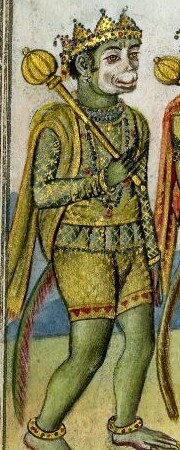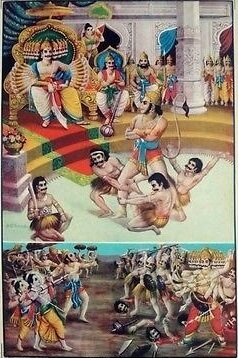Angada was the son of Vali in Ramayana. Both Vali, the father of Angada, and Sugriva, his brother, were orphan children and brought up by Anusuya and Gauthama Rishi in their Ashram. Later, Sugriva and Vali had been adopted by Vriksharaja of Kishkindha. They became happy in that new land, after they were taken over by Vriksharaja. Vali had married Tara, the daughter of physician, Sushena, and Angada was their lone son. When Vali was killed by Rama, Angada was crowned as the prince of Kishkindha and Sugriva had become the king of that country.

Angada was very active, being the monkey prince of Kishkindha. He had undergone internship training under the personal supervision of Jambhava, an aged bear of Kishkindha. Jambhava was also called as old Vriksharaja. He had good habits and always was found obedient to Sugriva. When Sugriva had sent various troops to different directions for the search operation of Sita, Angada was allotted as the leader of his troop, to move towards the southern direction.
During the war between Rama and Ravana, Sugriva had helped as a friend of Rama. On the first day, Angada had fought with Narantaka, the younger son of Ravana and killed him. On the second day, he fought with Meghanada, the elder son of Ravana. Meghanada was very a cunning fellow, and used several techniques during fighting to become victorious. But in the battle, he could not succeed. On the second day, Lakshmana had faced him, and Angada had helped him, as his defense. He also helped Sugriva, during the fight between Sugriva and Kumbhakarna, and finally, they had driven Ravana out of his fort. On the way outside the city of Lanka, Ravana had been killed by Rama.
Prior to the start of war, Rama and Sugriva had sent Angada as their mediator for compromise and ceasefire. He was courageous and finished his venture successfully, but Ravana needed war and desired for death.

Angada had ruled his country Kishkindha in peace and for a long time after Rama was crowned at Ayodhya.
Due to the active personality of Angada, he was liked by many kings and people. Lakshmana had put the name of his own son, after returning to Ayodhya as Angada. Later, Shatrughna had treated the original Angada as his own son.
Some stories like Uttara Ramayana which were treated as post period events of the Valmiki Ramayana were available but the authenticity could be attributed to Puranas like Vayu Purana and Padma Purana. Due to the crazy series of events, some authors had developed further extensions of stories, but in those stories the role of Angada was like a brave messenger only, but not as a warrior.
The Ashwamedha Yajna horse was released by Rama and it was escorted by Shatrughna with a small troop of armies as followers to it. It had roamed through many countries, and the kings and people there were happy to surrender under Rama, and submitted their revered offerings. The horse was noticed by a king of Nagaloka. The land of his kingdom was lower from the ground level. His name was Suratha and he was also a devotee of Rama. His father Veeramani was a strong devotee of God Shiva. Since the Nagaloka was always under the ground level, the people never had a chance to see Rama in their life.
Nagaloka was protected by the watch and ward of Adishesha, the serpent. One day, Suratha had obtained the permission of his father and captured the Ashwamedha yajna horse of Rama and kept the horse under his custody, underground at Nagaloka, where nobody could enter, without the approval of Adishesha. Shatrughna had come to know of the event. Shatrughna had deputed Angada to the palace of Suratha as his mediator for compromise and ceasefire. Angada was courageous and again finished his venture successfully but Suratha and his people needed to see Rama in their country. Hence, politely, Suratha requested with Angada to convey their intention to Rama through Shatrughna. Angada finished his commission.
It was not proper for the emperor to visit Nagaloka after commencement of the preparations for the Ashwamedha yaga, and the horse for the purpose being released. Hence Rama ordered to release the horse unconditionally but Suratha would not agree. War started between Shatrughna and Suratha. In order to help Shatrughna, Hanuman had visited Nagaloka.
In order to help his son, Veeramani had entered the war in Nagaloka for his own side and the war had acquired its higher degree of hotness. Since Veeramani was a strong devotee of God Shiva, his blissful presence and blessings was also sought by Veeramani and people of Nagaloka. The entire report of the situations was submitted by Angada to Rama immediately. Rama then thought it might be a better solution to visit personally to Nagaloka and invite them to the Ashwamedha Yaga and give them an opportunity to grace the occasion.
With Angada, Rama visited Nagaloka where they could see God Shiva who had just arrived. Rama then pleaded peace everywhere. To see the dual visit of Rama and Shiva together simultaneously in Nagaloka, everybody felt very happy and Suratha had immediately released and submitted the Yaga horse to Rama. Veeramani and the people of Nagaloka had submitted their revered offerings to both the Gods Shiva and Rama. Rama had invited them to the Ashwamedha yaga that would be held at Ayodhya.
All had disbursed to their own places. Then the Yajna horse had moved grazing towards the hermit of Valmiki Maharshi, followed by Shatrughna and his troops.
Thus, Angada could establish peace around his premises, by blessings of Rama.
राम राम राम राम ॥
It is humbly prayed for the blessings of God Rama upon us.
Next post, being of eight Chiranjeevis in Indian epics may not be missed. Five-fold personality would be presented separately in another article.
Readers may provide feedback and share this story with friends and family.

Leave a Reply